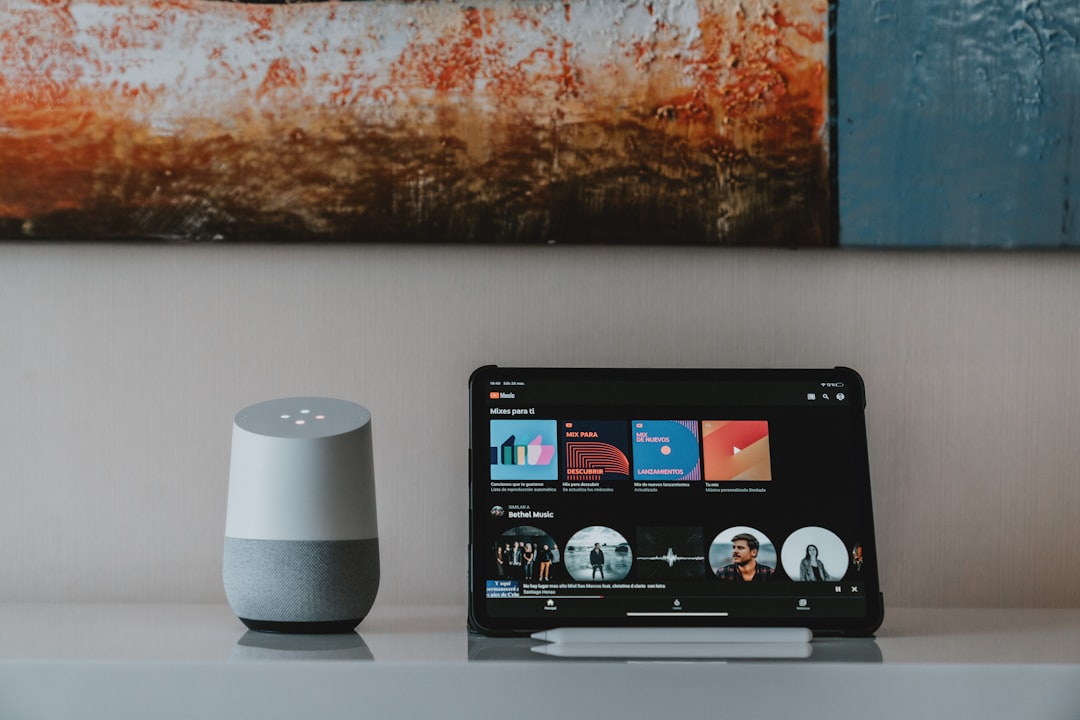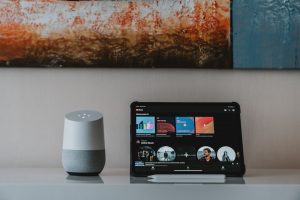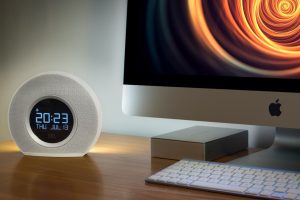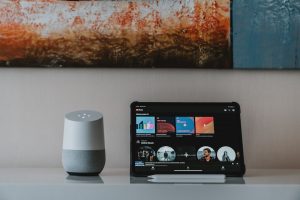2024 Smart Home Devices for Remote Workers: Efficiency Boost
Discover the top 2024 smart home devices boosting efficiency for remote workers. Enhance your productivity today!
Top Smart Home Devices
Smart Speakers
Smart speakers continue to be the cornerstone of smart home ecosystems in 2024. Devices like the Amazon Echo and Google Nest Audio offer seamless voice control, allowing users to manage their entire home with simple voice commands.
These speakers not only play music but also integrate with various smart home devices, providing a centralized hub for automation and control.
Smart Thermostats
Smart thermostats have become essential for energy-conscious homeowners. The latest models from brands like Ecobee and Nest Learning Thermostat provide advanced features such as learning your schedule, adjusting temperatures automatically, and offering energy-saving tips.
With the ability to control your home’s climate remotely, these devices ensure comfort and efficiency throughout the year.
Smart Lighting
Smart lighting systems have evolved significantly, offering more than just remote control of lights. Brands like Philips Hue and LIFX provide customizable lighting options, including color-changing bulbs and automated schedules.
These systems can enhance the ambiance of any room and are compatible with voice assistants for hands-free operation.
Smart Security Cameras
Home security has been revolutionized by smart cameras. Devices from companies like Arlo and Ring offer high-definition video, motion detection, and two-way audio.
These cameras provide real-time alerts and can be accessed remotely, ensuring homeowners can monitor their property from anywhere. Advanced features such as facial recognition and integration with other security systems add an extra layer of protection.
Smart Door Locks
Smart door locks offer convenience and enhanced security for modern homes.
Brands like August and Schlage have developed locks that can be controlled via smartphone apps, allowing for keyless entry and remote access management. These locks often feature integration with other smart home devices, providing a comprehensive security solution.
Smart Plugs
Smart plugs are a simple yet effective way to automate everyday appliances.
Devices from manufacturers like TP-Link and Wemo allow users to control power to any plugged-in device remotely. With features such as scheduling and energy monitoring, smart plugs are an easy entry point into smart home technology, offering convenience and potential energy savings.
Features Comparison
Voice Assistant Compatibility
In 2024, smart home devices are increasingly compatible with various voice assistants, including Alexa, Google Assistant, and Siri.
This compatibility allows users to control their devices through simple voice commands, enhancing convenience and accessibility. Devices like the latest smart speakers and displays have improved integration, offering seamless interaction with multiple ecosystems.
Energy Efficiency
Energy efficiency is a crucial feature in the latest smart home devices.
Many products now include energy monitoring capabilities, allowing users to track and optimize their energy consumption. Smart thermostats, for example, not only provide detailed energy reports but also suggest personalized settings to reduce energy usage without compromising comfort.
This feature is particularly beneficial for environmentally conscious consumers looking to minimize their carbon footprint.
Security Enhancements
Security remains a top priority in smart home technology. The best devices of 2024 come equipped with advanced security features, such as end-to-end encryption and multi-factor authentication, to protect user data.
Smart cameras and doorbells now offer enhanced video quality, facial recognition, and real-time alerts, ensuring comprehensive home surveillance. Additionally, many devices feature automatic software updates to safeguard against emerging threats.
Interoperability
Interoperability has seen significant improvements, with many smart home devices supporting the Matter protocol.
This universal standard enables devices from different manufacturers to work together seamlessly, providing users with more flexibility in building their smart home ecosystem. The ability to connect and control multiple devices through a single app enhances user experience and simplifies device management.
User-Friendly Interfaces
The latest smart home devices boast user-friendly interfaces, designed to cater to both tech-savvy users and beginners.
Intuitive apps and touchscreens provide easy navigation and control, while setup processes have become more straightforward. Many devices now offer customization options, allowing users to tailor their interfaces to suit their preferences, further enhancing usability.
User Experience Insights
Intuitive Interfaces
In 2024, the best smart home devices are defined by their intuitive interfaces, which prioritize user-friendly designs.
These devices feature streamlined apps and touchscreens that simplify navigation and control. The integration of voice commands has also been enhanced, allowing users to interact with their devices more naturally and efficiently.
This focus on intuitive design ensures that users of all tech-savviness levels can comfortably manage their smart home ecosystems.
Seamless Integration
Seamless integration remains a cornerstone of user experience for smart home devices in 2024. Devices are now designed to work harmoniously with a wide range of platforms, from popular voice assistants like Alexa and Google Assistant to various smart home ecosystems.
This interoperability allows users to customize their setups without worrying about compatibility issues, providing a cohesive and hassle-free experience.
Personalization and Customization
Personalization and customization features have been significantly enhanced in the latest smart home devices. Users can now tailor their devices to fit their unique preferences and routines.
From setting personalized schedules for lighting and climate control to creating custom scenes that activate multiple devices at once, the possibilities for customization are vast. This level of personalization ensures that smart homes can adapt to the individual needs and lifestyles of their users.
Enhanced Security and Privacy
With growing concerns over data security, the best smart home devices of 2024 prioritize enhanced security and privacy measures.
Manufacturers are implementing advanced encryption protocols and offering more transparent privacy policies to protect user data. Additionally, users have more control over their data, with options to manage permissions and access levels.
This commitment to security and privacy not only protects users but also builds trust in smart home technology.
Responsive Customer Support
Responsive customer support is a critical aspect of the user experience for smart home devices. In 2024, manufacturers are investing in robust support systems, including 24/7 helplines, live chat options, and comprehensive online resources.
This ensures that users can quickly resolve any issues they encounter, minimizing downtime and enhancing overall satisfaction with their smart home products.
Future Trends Analysis
Increased Integration and Interoperability
In 2024, smart home devices are expected to offer enhanced integration capabilities, allowing for seamless communication between different brands and platforms. This trend is driven by the growing demand for a unified smart home ecosystem where devices can interact without compatibility issues.
Protocols like Matter are gaining traction, promising to bridge gaps between various smart home technologies and providing users with a more cohesive experience.
AI and Machine Learning Enhancements
Artificial Intelligence (AI) and Machine Learning (ML) are set to revolutionize smart home devices in 2024. These technologies will enable devices to learn user preferences and behaviors, allowing for more personalized and efficient automation.
For example, smart thermostats will not only adjust temperatures based on patterns but also predict and optimize energy usage, leading to cost savings and increased convenience.
Focus on Energy Efficiency and Sustainability
As environmental concerns continue to rise, smart home devices in 2024 will increasingly emphasize energy efficiency and sustainability. Devices will be designed to minimize energy consumption and reduce carbon footprints.
Features such as energy monitoring and smart scheduling will become standard, empowering users to make environmentally conscious decisions without sacrificing comfort.
Enhanced Security and Privacy Features
With the proliferation of connected devices, security and privacy remain paramount concerns for consumers. In 2024, smart home devices will incorporate advanced security protocols, including end-to-end encryption and biometric authentication.
Manufacturers will prioritize user data protection, ensuring that personal information remains secure and private, thereby building consumer trust.
Voice and Gesture Control Advancements
Voice control remains a popular feature in smart home devices, and 2024 will see further advancements in this area. Improved natural language processing will make voice commands more intuitive and responsive.
Additionally, gesture control is emerging as a complementary technology, allowing users to interact with devices through simple hand movements, providing an alternative to voice commands in noisy or private environments.
FAQ
Q1: Who should consider buying the best smart home devices of 2024?
A1: The best smart home devices of 2024 are ideal for a wide range of users. Students living in dorms or shared apartments can benefit from smart lighting and security devices for convenience and safety. Frequent travelers will appreciate smart locks and surveillance systems that allow them to monitor their homes remotely. Additionally, tech enthusiasts who enjoy integrating the latest technology into their daily lives will find these devices enhance their home automation experience.
Q2: Are the best smart home devices of 2024 compatible with other devices or software?
A2: Yes, most of the top smart home devices of 2024 are designed with compatibility in mind. They typically support popular ecosystems like Amazon Alexa, Google Assistant, and Apple HomeKit, allowing seamless integration with other smart devices and services. Before purchasing, it’s advisable to check the specific compatibility details to ensure the device will work with your existing setup and preferred software platforms.
Q3: When is the best time to upgrade to the latest smart home devices, or are there better alternatives?
A3: The best time to upgrade to the latest smart home devices is often during major sales events like Black Friday, Cyber Monday, or Prime Day, when discounts are prevalent. However, if your current devices are functioning well and meet your needs, you might consider waiting for the next generation of technology, as innovations are continually emerging. It’s also wise to research and compare alternatives to ensure you’re choosing the best device for your specific requirements and budget.
Takeaway
Ready to make an informed decision on your next tech purchase? Dive into our hands-on product reviews to get a real feel for the gadgets you’re eyeing. Compare specs side by side to find the perfect match for your needs. Still have questions? Head over to the official site for even more details. Your tech upgrade awaits – let’s make sure you choose the best fit for you! As outlined in Reuters’ recent publication,
References
- Statista (2024) reports global smart home device revenue to exceed $170 billion by 2025.
- Samsung leads in mobile and smart home device ecosystems with its Galaxy and SmartThings platforms.











Comments